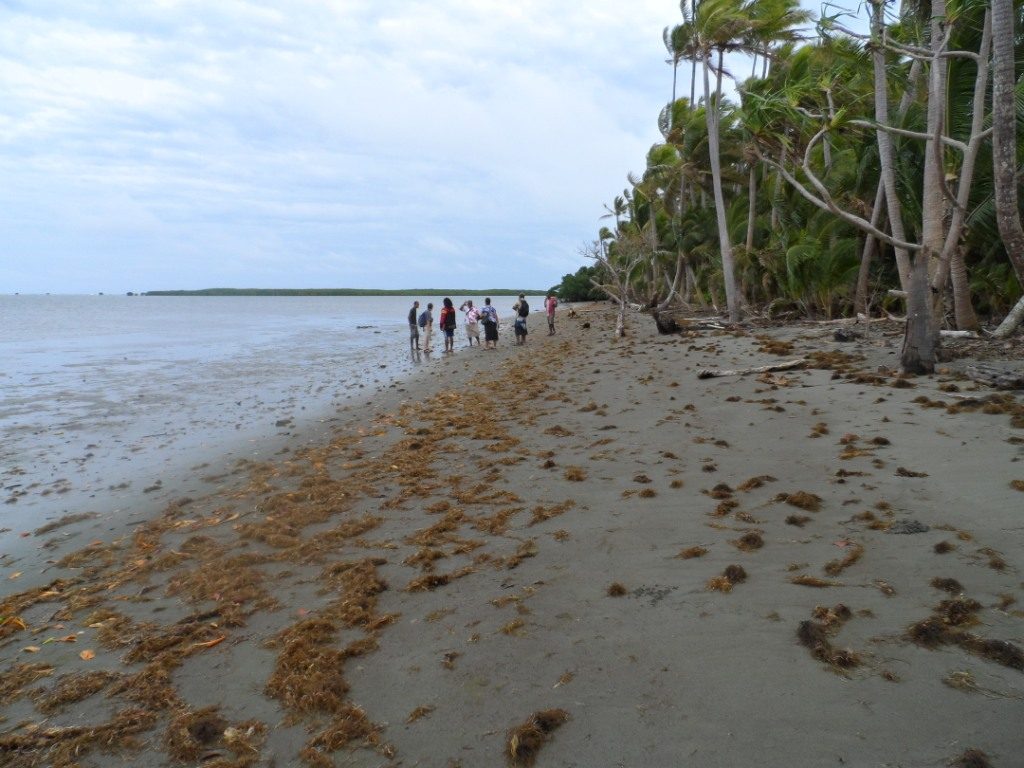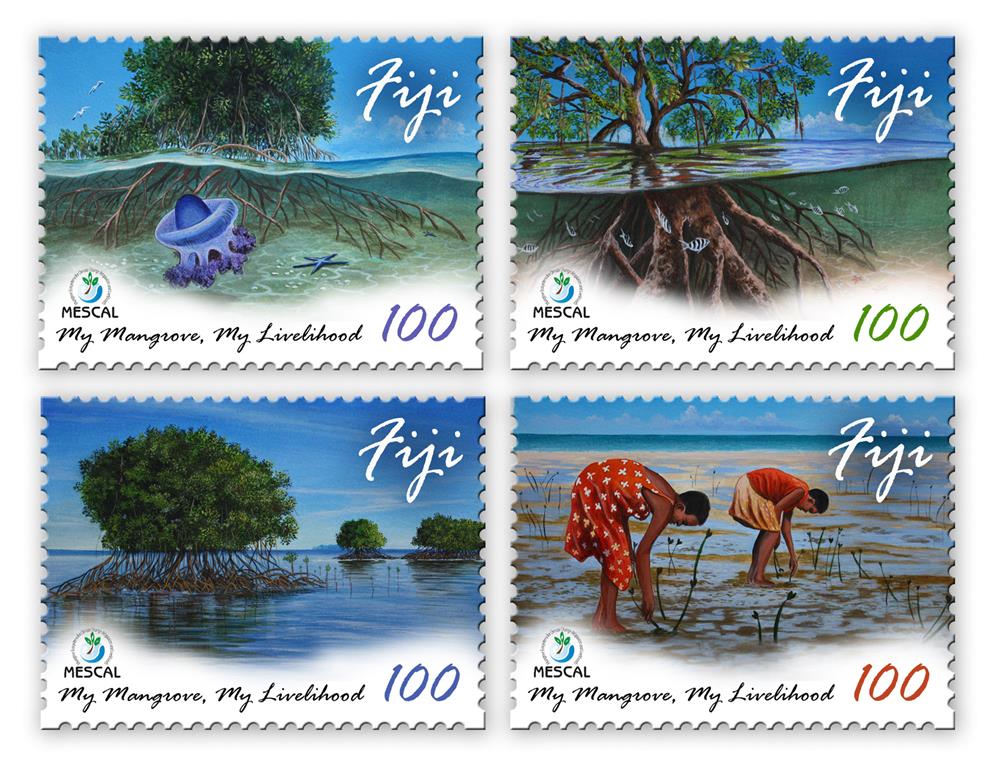What smells bad and helps protect people that live by the ocean from tsunamis?
The answer – Mangroves!
Mangroves are a kind of tree that grow in saltwater, instead of on dry land. Their sturdy roots form a net pattern in the water that slows water that comes into shore. By slowing down the waves, mangroves can steal energy from tidal waves that could destroy towns.
This scale model shows how mangrove forests protect coasts from the impact of waves. pic.twitter.com/pEK4hU5aZV
— Nature is Amazing ☘️ (@AMAZlNGNATURE) March 28, 2019
Slowing water also helps because it allows nutrients in the water to settle on the bottom and make the ground nutritious which allows seafood to live and grow which people that live around the mangroves can eat. Mangrove’s ability to slow water also allows nutrients in the water to settle, creating a nutrient-rich sediment layer. This allows the sea creatures that people depend on as their livelihood to grow and thrive. Mangrove roots are also great at locking up carbon dioxide (CO2) in the air, which helps clean up air pollution.
This video does a great job of explaining the importance of mangroves – check it out!
So what is MESCAL?
Our team worked from January to March to learn more about a project called the Mangroves Ecosystem for Climate Change Adaptations and Livelihoods (MESCAL) Project that wanted to help protect mangroves in the country of Fiji.

Nasoata mangrove island, in Fiji. Nasoata Island was part of the MESCAL project’s working area in Fiji. Copyright: Vainuupo Jungblut
In Fiji, mangroves are threatened by many things, but primarily development of hotels and resorts as well as sea level rise. This is because a lot of resort developers pour waste into mangroves which poisons them. As sea levels rise due to climate change, mangroves will over time move further inland to keep their roots in the right amount of water. If they back up into developed areas, like roads, the mangroves won’t be able to keep moving, leading to their population declining..
The goal of the MESCAL project was to provide a basis to help protect mangroves in Fiji and also protect the peoples that live close to shore. They wanted to give Fijian people and the government better knowledge of what mangroves can do for them and get more people interested in protecting the mangroves. MESCAL ended up gathering a lot of important information about the species composition and biomass of mangroves in Fiji, as well as their role in removing carbon dioxide from the atmosphere.
So what did MESCAL do, anyway?
MESCAL was a multipart, multi-country project with lots of activities that supported their overall goals. In Fiji, these activities included:
Socioeconomic Surveys
The socioeconomic surveys done served as a way to evaluate the importance of the mangroves to the livelihoods of the local communities, done through interviews and discussions with village members. The results of these surveys illustrated the impact of mangroves on local communities livelihoods. For example, it was found that over half of most households’ income came from fishing species that spawn and grown up in mangroves.
Biodiversity Surveys
The biodiversity surveys were an important part of the MESCAL project. Before this project, there had not been a systematic survey of the different kinds of animals and plants that could be found in Fiji. The field team for the surveys documented species of all kinds, including a kind of mangrove that had never been seen in Fiji before and many IUCN Red List species. The data collected can be used as a baseline to measure degradation of the mangrove forest communities in the future.
Shoreline Assessments
The shoreline surveys were performed to develop baselines for a long-term monitoring program of the mangrove ecosystems, and were done by assessing the condition of shoreline mangroves through video analysis. Through these assessments, it was found that a majority of the shoreline mangroves were in good condition with minimal dieback and that the main drivers of change were cutting, clearing, and lightning strikes.
Carbon Assessments
Lastly, the carbon assessments were done to help quantify the importance of mangrove ecosystems in carbon storage. Soil samples were taken from various sites of various conditions and sent to Oregon State University, where carbon concentration assessments were performed. From these assessments, it was determined that the mangroves store approximately 15 million tonnes of CO2 equivalent as carbon standing stocks and that the amount of carbon in these standing stocks decreased significantly in areas that had been converted from mangrove ecosystems.
Community Engagement
“We have this approach where instead of bringing consultants in, we had in-country coordinators… also people who didn’t want an NGO running the show, we wanted people who were in the government. So the approach was that you get people who were already in government, so we up-scaled the people for capacity building and environment departments of each of the five countries.” – Viliame Waqalevu, Technical Officer of MESCAL, March 2019.
One of the unique things about MESCAL was how they structured their team in Fiji. Instead of relying just on IUCN staff or outside experts, MESCAL hired people from Fiji to lead and work on the project. The leader in Fiji, in-country coordinator Neema Nand, helped to coordinate with Fijian government as well as lead the team in other parts of the project. In the field, there were contractors from the University of the South Pacific and villagers who lived nearby – so people with all sorts of backgrounds and education levels could get involved in mangrove conservation. By training and working with “non-experts”, MESCAL wanted to build their skills and capacity to carry on mangrove conservation work after they had left.
Outside of the people who were working on data collection, MESCAL wanted to make sure everyone in these communities knew about the importance of mangroves. To that end, MESCAL ran a mangrove awareness campaign. The campaign had three main prongs:
- community mangrove replanting days – getting the whole community to help restore the mangroves. Doing this gave MESCAL an opportunity to teach people about the different species of mangroves and the services they provide the community.
- Champions of Mangroves – Important people in the community that served as ambassadors of the mangroves. The messages that MESCAL were promoting were more likely to be listened to if people from the community backed them up.
- “My Mangrove, My Livelihood” – a slogan they used for a larger education campaign. By making the link from mangroves to the fisheries that villagers depended on for income, MESCAL motivated people to care more about their local mangrove forests.

The campaign even became an official Fijian stamp set!
Successes
Through the course of the MESCAL project, there were various successes that have influenced various aspects of mangrove conservation in Fiji. The MESCAL project produced the first carbon assessments in Fiji, as well as produced baseline data for the biodiversity and condition of the mangrove ecosystems. The project was also instrumental in involving local communities in conservation actions and helping villages overcome conflict between each other. Additionally, the Mangrove Management Plan in Fiji was updated for the first time in over two decades due to the outputs of the MESCAL project. Along with the Mangrove Management Plan, the Pacific Mangrove Charter was created to help protect the mangrove ecosystems in the pacific islands.
Room to Grow
There is still room to improve in mangrove conservation. The MESCAL team ran into some community pushback when they were trying to establish one area as a protected site. Community involvement is key in all conservation efforts, so improving the way that future projects reach out to villages in Fiji could really help the next group that comes along.
However, there is no doubt that MESCAL has paved the way for mangrove conservation in the South Pacific and in Fiji. We look forward to seeing what is next for mangrove projects in this region!
@Australian_Navy and @AustralianArmy members have contributed to planting 50,000 mangrove saplings at a coastal area near Suva in Fiji during Indo-Pacific Endeavour 2018.
The activity was part of a Fijian initiative to plant one million mangroves in 2018. pic.twitter.com/5ZKBiqTdju
— Defence Australia (@DeptDefence) June 25, 2018
To find out more check out these sites:
To help with mangrove conservation in your area, check out these citizen science projects!
And chat with us if you want to know more about this project! We’re all on Twitter:
Fosse: @fass_sea
Gavin: @fishingavin
Linnea: @linneamorgan_14
– Megan “Fosse” Fass, Gavin Gao, and Linnea Morgan
for BIOL 420: Ocean Conservation and Sustainability, Spring 2019
References
Heider, C. (2013). MESCAL Carbon Assessment: Rewa Delta Mangrover Reference Levels & Emissions Due to Mangrove Conversion. 27.
IUCN. (2014). Review of Policy and Legislation Relating to the Use and Management of Mangroves in Fiji. Retrieved March 28, 2019, from IUCN website: https://www.iucn.org/content/samoa-leads-five-pacific-island-nations-signing-pacific-mangroves-charter
Mackenzie, J., Duke, N. C., Wood, A. (2013). MESCAL MangroveWatch assessment of shoreline mangroves in Fiji. 38.
Watling, D. (2013). Mangrove Management Plan for Fiji. 88.
 Follow
Follow